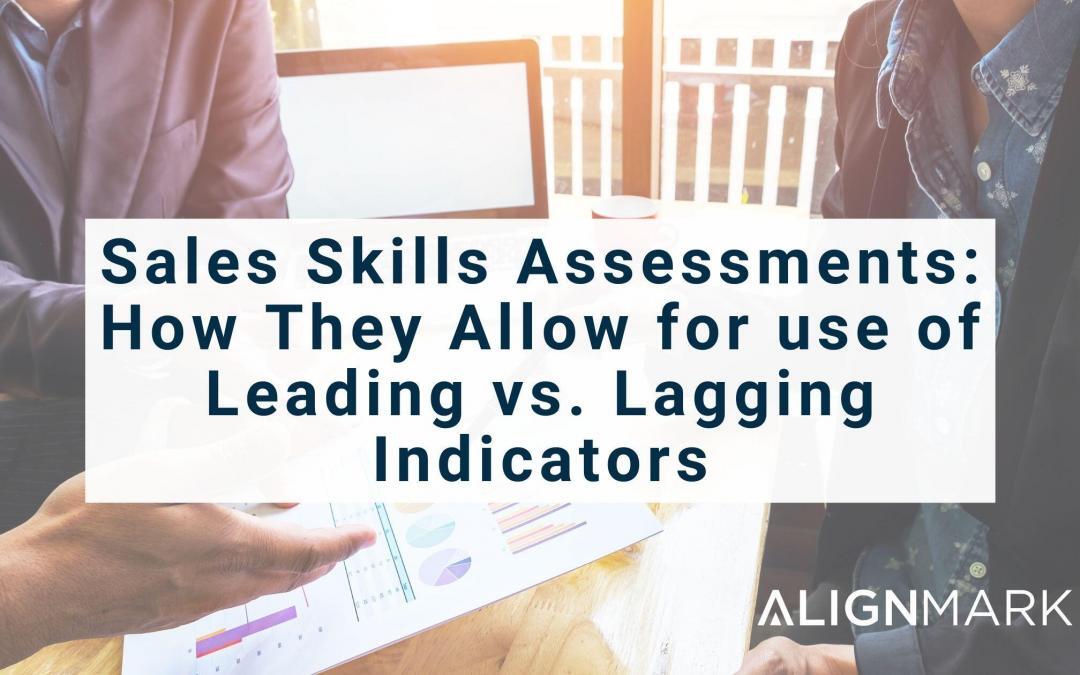Table of Contents
Sales Skills Assessments: How They Allow for use of Leading vs. Lagging Indicators
If you are reaching the end of the quarter, and your sales numbers are not where they should be, ask yourself why? If external business factors can be ruled out, turn your attention inward, to your talent management process. Is your organization utilizing sales skills assessments? One of the many reasons sales skills assessments are great, is that they allow for use of leading vs. lagging indicators.
What are leading vs. lagging KPI’s?
According to geckoboard, leading indicators measure the activities necessary to achieve your goals. These indicators lead to results and come first. Lagging indicators are essentially outputs, they measure results.
Is your sales team run by leading indicators or lagging hindsight?
All it takes is a brief look within the talent management practices of the organization to answer this question. According to McKinsey’s War for Talent surveys (200 companies, 1200 respondents) the percentage of companies engaged in positive talent leadership action and execution is very small.
It is true that when it comes to talent leadership, most organizations are failing, and failure is easily traceable to a weak mindset and belief. In fact, 72% of managers say that winning the war for talent is critical, yet only 9% are confident that their current actions will lead to a stronger talent pool in the next three years.
In summary, the McKinsey survey lists the following as views of senior managers’ beliefs about their own organizations:
- Brings in talented people……….……19%
- Develops people effectively………….3%
- Retains top talent……………….…………8%
- Removes poor performers…………..3%
- Knows the A, B, and C players…….16%
Differences between leading and lagging indicators
Below are only a few of the differences between leading and lagging indicators. Which do you measure?
| Leading Indicators | Lagging Indicators |
| Quality of hires | Quantity of hires |
| Gap Analysis of results weekly | End of year results |
| Skills identification and gap analysis of incumbent sales force | Time to fill a position |
| Leadership Involvement | Percent of quota attained |
| Identification of “at risk” incumbents | Turnover |
| Engagement levels | Objectives made |
Where do you think your company falls? How can you improve your leading indicators?
Accurate information drives effective strategies. This is where sales skills assessments come into play, they measure Interactive skills and personality factors/fit, allowing you to predict probability of success. This is good news for sales organizations, because, unlike many other functional areas, sales organizations already have great appreciation for accurate information. Operating metrics are a familiar form of sales information and receive intense attention in all sales organizations. But operating metrics alone are not enough.
- Sales leaders need to be passionately and diligently focused on the knowledge, skills, and abilities (i.e., the competencies) required in all their positions and they need to be likewise focused on the knowledge, skills, and abilities of their incumbents (individual contributors and leadership alike), internal candidates, and external candidates as well.
- The sales organization with accurate information about their position requirements, and the corresponding level of human capital knowledge, skills, and abilities available to fill those positions, is in the best position to be more strategic and intelligent when making all human capital decisions (i.e., selection, promotion, training, succession planning, performance management, etc.). In this definition, “passionately and diligently” means an unwavering commitment to measure, measure, and measure again.
Great sales organizations extend their measurements beyond operational metrics to include significant focus on key human capital metrics: skills, abilities, knowledge, engagement and retention levels, quality-of-hire, ROI, etc. These measures are examples of “leading indicators” that great sales organizations focus on and attend to as they know that such indicators do accurately predict ultimate operating metrics like revenue and profitability. All measurement should be directed at providing better information for improved decision-making.
We have found repeatedly when critical, strategic decision-making is attempted without rigorous attention to the predictive data and metrics, wrong decisions are made which will lead to poor sales performance. If a sales leader can lead their managers and sales people to arrive at a point–mentally (through initial belief and eventual successes) where there is “passionate and diligent focus,” both on the targets that will drive its future success and the competencies needed to drive that success, much progress will have been made in building this core belief.
Top 7 Core Beliefs Great Sales Organizations Share
- Better Talent equals competitive advantage
- Talent Leadership “Mindset” is the catalyst for action
- Strengthening the talent pool is every leader’s job
- Talent “Gold Standard” has been established (be a role model)
- Leaders, especially senior leaders, must be held accountable for aggressively developing sales talent
- Real money must be invested in Talent Leadership
- Talent Review processes are critical
Don’t lag behind without focus on leading indicators. Hindsight with poor results is a position your sales organization does not need to face.
Related resources: Pre-Employment Assessments – Everything you need to know
Related blog: 5 Steps to Hiring Better Salespeople
This blog has been revised. It was originally posted on 6/29/2010

 Dr. Jaffee (M.A., Ph.D.) is a recognized expert in the field of assessments, and has created effective HR Solutions used by millions of people.
Dr. Jaffee (M.A., Ph.D.) is a recognized expert in the field of assessments, and has created effective HR Solutions used by millions of people.